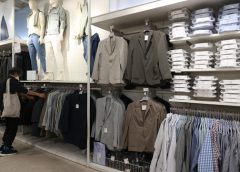
Fashion industry thrives as furniture sales gather dust
[ad_1]
![A shopper browses through clothes at a clothing shop in Seoul on April 13. [YONHAP]](https://koreajoongangdaily.joins.com/data/photo/2022/08/16/2b09c0e0-7662-40a5-91d0-2b2a0d569b2f.jpg)
A shopper browses through clothes at a clothing shop in Seoul on April 13. [YONHAP]
The lifting of social distancing measures in April boosted the fashion industry as more people went out, and hurt furniture and interior decoration companies, which thrived when people were stuck at home.
Earnings at major fashion companies in the second quarter grew by as much as 75 percent on year, and the second quarter is usually less lucrative because summer clothes are relatively low-priced compared to fall or winter clothes. But this year, the volume increased as people went back to offices and restaurants after the lifting of social distancing measures.
Samsung C&T’s fashion division reported sales of 515 billion won ($393 million) and operating profit of 62 billion won in the second quarter, an increase of 16 percent for sales and 44.2 percent for operating profit. Samsung C&T credited “recovery of customer sentiment” for the strong performance.
Shinsegae International’s sales increased 12.7 percent to 383.9 billion won and net profit increased 74.6 percent to 33.3 billion won. “These results were a benefit of a rebound in clothing consumption due to the lifting of social distancing,” explained a spokesperson.
The Handsome clothing brand saw sales increase 14.3 percent to 357.4 billion won and net profit of 17.7 billion won, down 5.4 percent.
“The demand for clothing has increased due to re-opening and sales in the outdoor and sportswear category have been particularly strong,” said a spokesperson for Handsome.
Profit fell slightly due to costs of new businesses, such as the launch of a new perfume line, the company said.
Kolon Industries FnC, the fashion division of Kolon Industries, saw sales of 309.9 billion won, a 22.9 percent increase, while operating profit was 23.4 billion won, up 52.9 percent.
“This is our highest performance in the second quarter,” an official from Kolon Industries FnC said. “Our golfwear brand’s performance has grown significantly as the number of new golfers has increased.”
There are mixed predictions for the second half. Some expect equally buoyant results, while others say business could stagnate due to high inflation.
On the flip side, furniture and interior decoration companies performed poorly in the second quarter.
The demand for furniture and interior design increases when people move or buy new homes, but housing transactions have been sluggish due to interest rate hikes and tightened loan regulations. Rising raw material prices and increased logistics costs are also contributing factors to the deterioration of profitability for furniture and interior products.
Hanssem’s net profit in the second quarter was 988 million won, down 96.1 percent from the same period last year. Sales decreased 12 percent to 500 billion won. LX Hausys’ sales increased 5.7 percent to 948.5 billion won, but its net loss grew 241.3 percent to 47.5 billion won.
Hyundai Livart Furniture’s sales increased 2 percent to 360.1 billion won, but it saw a net loss of 610 million won compared to a net profit of 920 million won in the same quarter the previous year. In the case of Shinsegae’s Casamia, sales jumped 40.5 percent to 67.8 billion won, but the company reported a net loss of 3.9 billion won, 85.7 percent higher than a year earlier.
For the furniture and interior decoration industry, there’s optimism for the second half.
“We expect earnings to improve as measures such as easing regulations on loans for first-time homebuyers and delaying and suspending the transfer tax for people who own more than one piece of real estate will act favorably on the market,” said a spokesperson for Hanssem.
“We will gradually recover profitability in the second half of the year by expanding our total interior distribution network and strengthening our overseas premium furniture lineup,” said a spokesperson for Hyundai Livart Furniture.
BY BAEK IL-HYUN [lim.jeongwon@joongang.co.kr]
[ad_2]
Source link


